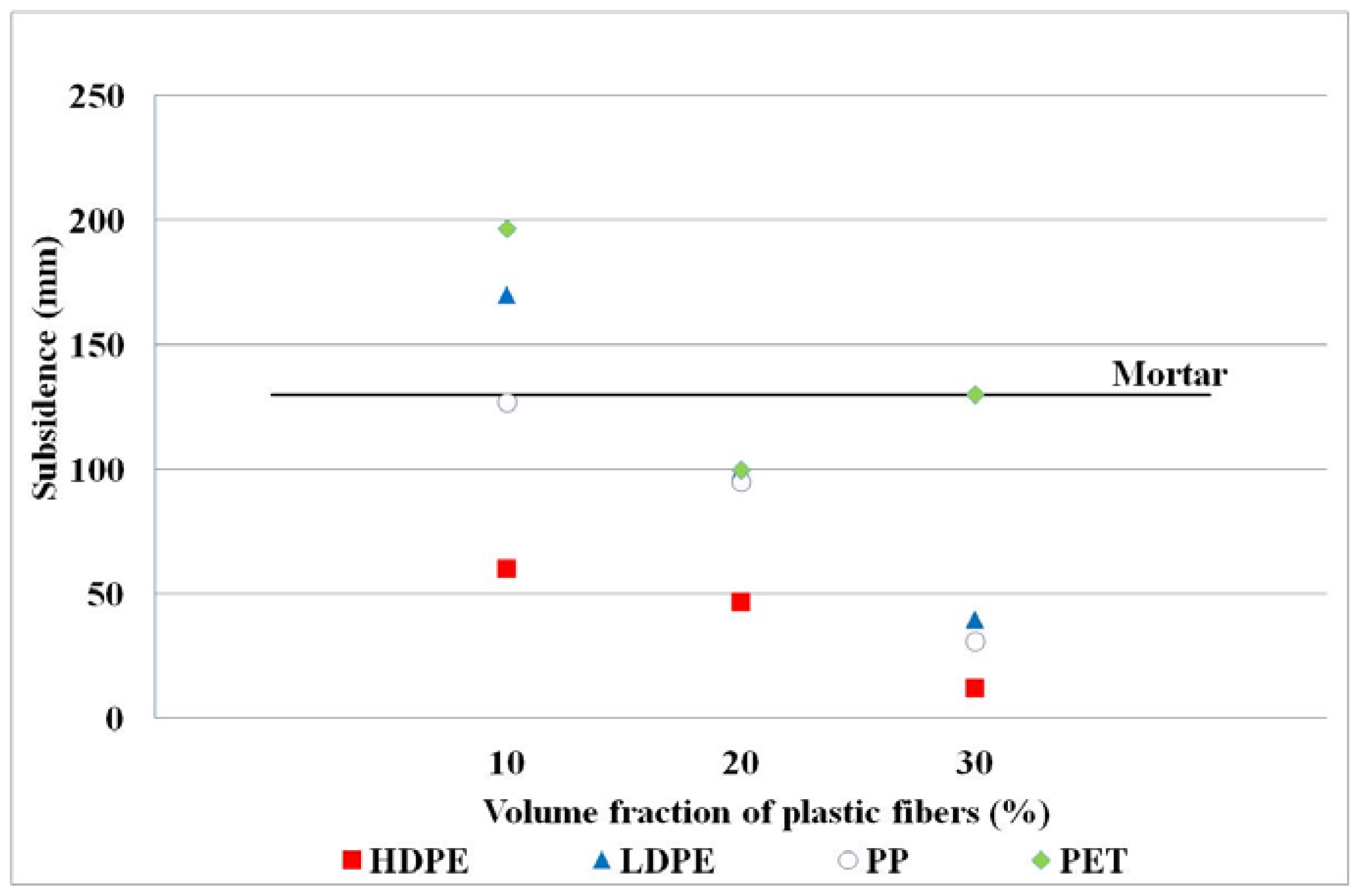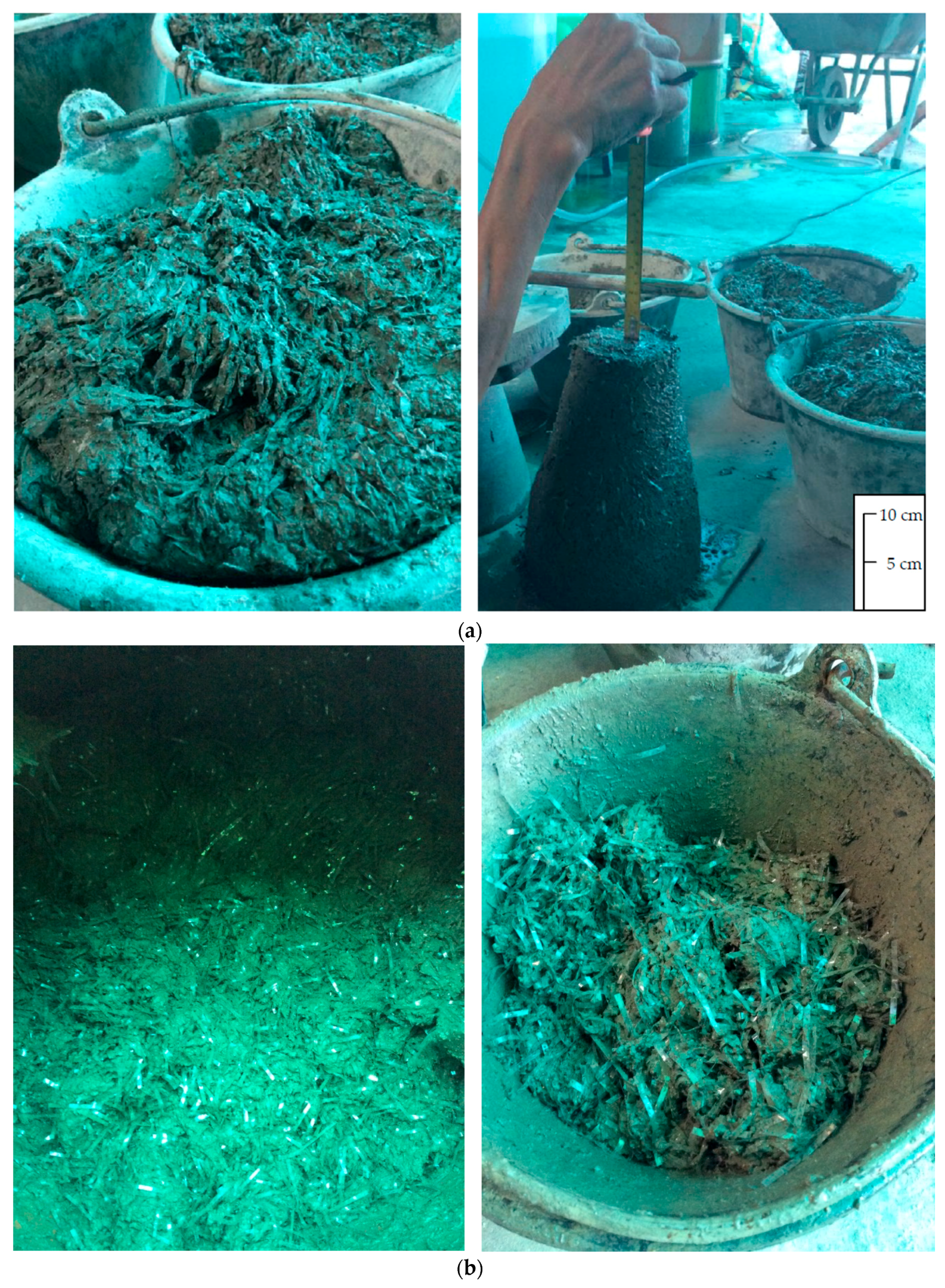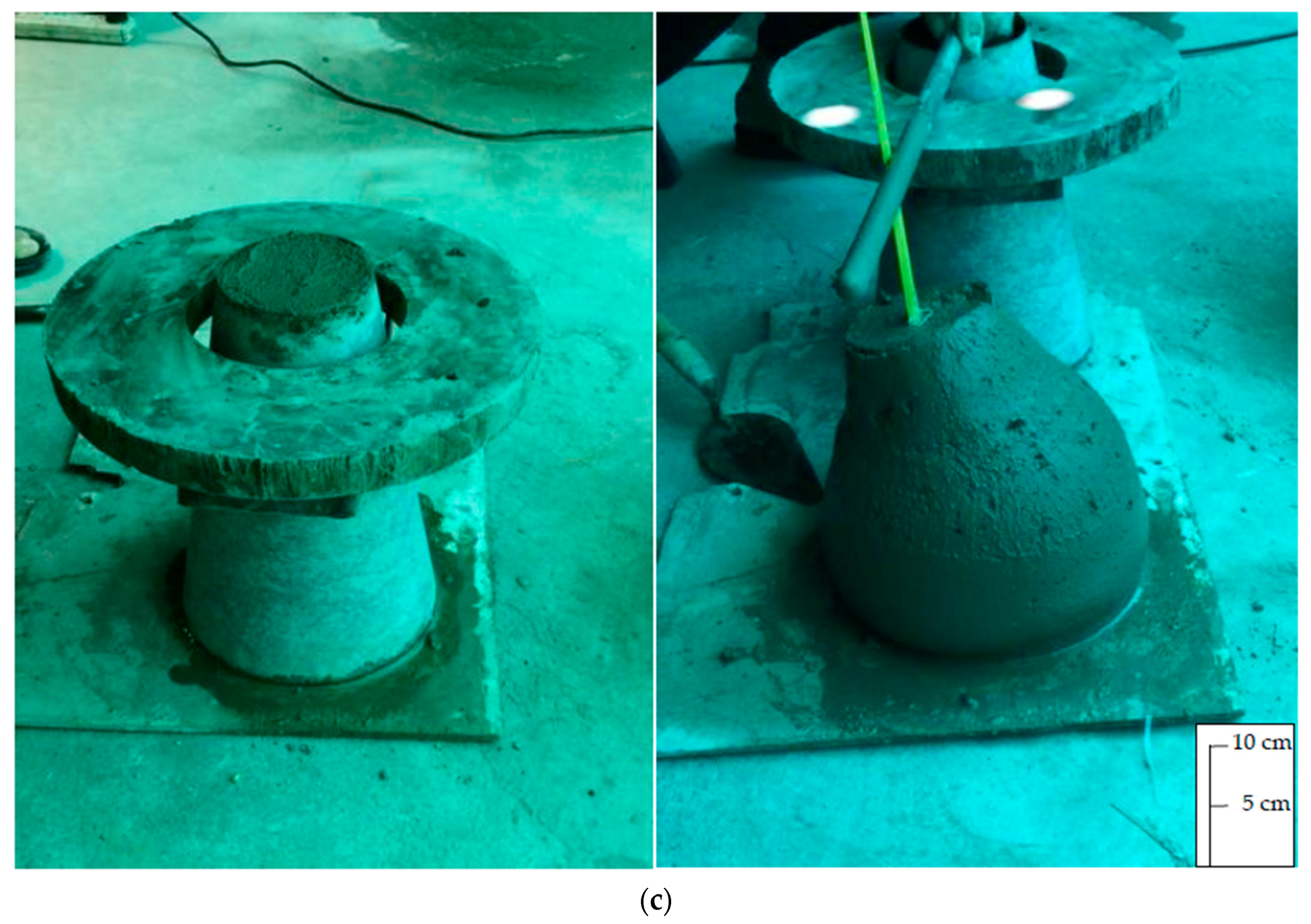Potential Use of Plastic Wastes for Low Thermal Conductivity Concrete
Abstract
:1. Introduction
2. Materials and Methods
2.1. Plastic Fiber Preparation
2.2. Cement and Sand Preparation
2.3. Experimental Conditions and Concrete Processing
2.4. Plastic Fiber Test
2.5. Concrete Test
3. Results and Discussions
3.1. Property of Plastic Fibers
3.2. Property of Concrete
3.2.1. Workability
3.2.2. Bulk Density and Porosity
3.2.3. Thermal Conductivity
3.2.4. Tensile and Compressive Strengths
4. Conclusions
Author Contributions
Funding
Acknowledgments
Conflicts of Interest
References
- PlasticsEurope. Available online: http://www.plasticseurope.org/ (accessed on 30 April 2017).
- Junod, T.L. Gaseous Emissions and Toxic Hazards Associated with Plastics in Fire Situations—A Literature Review; NASA-TN-D-8338; NASA: Washington, DC, USA, 1976.
- Jambeck, J.R.; Geyer, R.; Wilcox, C.; Siegler, T.R.; Perryman, M.; Andrady, A.; Narayan, R.; Law, K.L. Plastic waste inputs from land into the ocean. Science 2015, 347, 768–771. [Google Scholar] [CrossRef] [PubMed]
- Alqahtani, F.K.; Ghataora, G.; Khan, M.I.; Dirar, S. Novel lightweight concrete containing manufactured plastic aggregate. Constr. Build. Mater. 2017, 148, 386–397. [Google Scholar] [CrossRef]
- Mattsson, K.; Hansson, L.A.; Cedervall, T. Nano-plastics in the aquatic environment. Environ. Sci. Process. Impacts 2015, 17, 1712–1721. [Google Scholar] [CrossRef] [PubMed]
- PCD. Available online: http://www.pcd.go.th/ (accessed on 23 December 2017).
- Fraternali, F.; Ciancia, V.; Chechile, R.; Rizzano, G.; Feo, L.; Incarnato, L. Experimental study of the thermo-mechanical properties of recycled PET fiber-reinforced concrete. Compos. Struct. 2011, 93, 2368–2374. [Google Scholar] [CrossRef]
- Kaufmann, J.; Frech, K.; Schuetz, P.; Münch, B. Rebound and orientation of fibers in wet sprayed concrete applications. Constr. Build. Mater. 2013, 49, 15–22. [Google Scholar] [CrossRef]
- Alani, A.M.; Beckett, D. Mechanical properties of a large scale synthetic fibre reinforced concrete ground slab. Constr. Build. Mater. 2013, 41, 335–344. [Google Scholar] [CrossRef]
- Oluokun, F.A.; Burdette, E.G.; Deatherage, J.H. Splitting tensile strength and compressive strength relationships at early ages. Mater. J. 1991, 88, 115–121. [Google Scholar]
- Choi, Y.; Yuan, R.L. Experimental relationship between splitting tensile strength and compressive strength of GFRC and PFRC. Cem. Concr. Res. 2015, 35, 1587–1591. [Google Scholar] [CrossRef]
- Kim, S.B.; Yi, N.H.; Kim, H.Y.; Kim, J.H.J.; Song, Y.C. Material and structural performance evaluation of recycled PET fiber reinforced concrete. Cem. Concr. Compos. 2010, 32, 232–240. [Google Scholar] [CrossRef]
- Hasan, M.J.; Afroz, M.; Mahmud, H.M.I. An experimental investigation on mechanical behavior of macro synthetic fiber reinforced concrete. Int. J. Civ. Environ. Eng. 2011, 11, 18–23. [Google Scholar]
- Hsie, M.; Tu, C.; Song, P.S. Mechanical properties of polypropylene hybrid fiber-reinforced concrete. Mater. Sci. Eng. A 2008, 494, 153–157. [Google Scholar] [CrossRef]
- Ochi, T.; Okubo, S.; Fukui, K. Development of recycled PET fiber and its application as concrete-reinforcing fiber. Cem. Concr. Compos. 2007, 29, 448–455. [Google Scholar] [CrossRef]
- Pacheco-Torgal, F.; Ding, Y.; Jalali, S. Properties and durability of concrete containing polymeric wastes (tyre rubber and polyethylene terephthalate bottles): An overview. Constr. Build. Mater. 2012, 30, 714–724. [Google Scholar] [CrossRef] [Green Version]
- Golewski, G.L. Generalized fracture toughness and compressive strength of sustainable concrete including low calcium fly ash. Materials 2017, 10, 1393. [Google Scholar] [CrossRef] [PubMed]
- Sukontasukkul, P. Use of crumb rubber to improve thermal and sound properties of pre-cast concrete panel. Constr. Build. Mater. 2009, 23, 1084–1092. [Google Scholar] [CrossRef]
- Iucolano, F.; Liguori, B.; Caputo, D.; Colangelo, F.; Cioffi, R. Recycled plastic aggregate in mortars composition: Effect on physical and mechanical properties. Mater. Des. 2013, 52, 916–922. [Google Scholar] [CrossRef]
- Soroushian, P.; Plasencia, J.; Ravanbakhsh, S. Assessment of reinforcing effects of recycled plastic and paper in concrete. Mater. J. 2003, 100, 203–207. [Google Scholar]
- Choi, Y.W.; Moon, D.J.; Chung, J.S.; Cho, S.K. Effects of waste PET bottles aggregate on the properties of concrete. Cem. Concr. Res. 2005, 35, 776–781. [Google Scholar] [CrossRef]
- Fraternali, F.; Farina, I.; Polzone, C.; Pagliuca, E.; Feo, L. On the use of R-PET strips for the reinforcement of cement mortars. Compos. Part B Eng. 2013, 46, 207–210. [Google Scholar] [CrossRef]
- Kim, J.H.J.; Park, C.G.; Lee, S.W.; Lee, S.W.; Won, J.P. Effects of the geometry of recycled PET fiber reinforcement on shrinkage cracking of cement-based composites. Compos. Part B Eng. 2008, 39, 442–450. [Google Scholar] [CrossRef]
- Koo, B.M.; Kim, J.H.J.; Kim, S.B.; Mun, S. Material and structural performance evaluations of Hwangtoh admixtures and recycled PET fiber-added eco-friendly concrete for CO2 emission reduction. Materials 2014, 7, 5959–5981. [Google Scholar] [CrossRef] [PubMed]
- Marzouk, O.Y.; Dheilly, R.M.; Queneudec, M. Valorization of post-consumer waste plastic in cementitious concrete composites. Waste Manag. 2007, 27, 310–318. [Google Scholar] [CrossRef] [PubMed]
- Panyakapo, P.; Panyakapo, M. Reuse of thermosetting plastic waste for lightweight concrete. Waste Manag. 2008, 28, 1581–1588. [Google Scholar] [CrossRef] [PubMed]
- Al-Manaseer, A.A.; Dalal, T.R. Concrete containing plastic aggregates. Concr. Int. 1997, 19, 47–52. [Google Scholar]
- Batayneh, M.; Marie, I.; Asi, I. Use of selected waste materials in concrete mixes. Waste Manag. 2007, 27, 1870–1876. [Google Scholar] [CrossRef] [PubMed]
- Klein, R. Laser Welding of Plastics, 1st ed.; Wiley-VCH: Hoboken, NJ, USA, 2011. [Google Scholar]
- Chan, J. Thermal Properties of Concrete with Different Swedish Aggregate Materials; Rapport TVBM (5000-Serie); Lund University: Lund, Sweden, 2014. [Google Scholar]
- Yun, T.S.; Jeong, Y.J.; Youm, K.S. Effect of surrogate aggregates on the thermal conductivity of concrete at ambient and elevated temperatures. Sci. World J. 2014, 2014, 9. [Google Scholar] [CrossRef] [PubMed]
- Tasdemir, C.; Sengul, O.; Tasdemir, M.A. A comparative study on the thermal conductivities and mechanical properties of lightweight concretes. Energy Build. 2017, 151, 469–475. [Google Scholar] [CrossRef]
- Standard Specification for Polyolefin Chopped Strands for Use in Concrete; ASTMD7508m; ASTM International: West Conshohocken, PA, USA, 2015.
- Guide for Specifying, Proportioning, and Production of Fiber-Reinforced Concrete; ACI 544.3R-08; ACI Committee: Farmington Hills, MI, USA, 2008.
- Standard Test Method for Unit Weight and Voids in Aggregate; ASTMC29; ASTM International: West Conshohocken, PA, USA, 2009.
- SCG. Cement and Applications, 6th ed. 2010. Available online: http://www.cpacacademy.com/index.php?tpid=0149/ (accessed on 15 December 2017).
- ANVAL. Bulk Density Chart. 2018. Available online: http:// http://www.cpacacademy.com/index.php?tpid=0149/ (accessed on 27 September 2017).
- Standard Test Method for Seive Analysis of Fine and Coarse Aggregates; ASTMC136; ASTM International: West Conshohocken, PA, USA, 2001.
- CPAC. Standard Methods for Testing Aggregate and Concrete. 1999. Available online: http://http://www.cpacacademy.com/index.php?tpid=0064/ (accessed on 15 December 2017).
- Thai Ethoxylate Company Limited or TEX. Available online: http://www.tex.co.th (accessed on 1 May 2017).
- Standard Test Method for Slump of Hydraulic Cement Concrete; ASTMC143; ASTM International: West Conshohocken, PA, USA, 2000.
- Standard Practice for Making and Curing Concrete Test Specimens in the Laboratory; ASTMC192; ASTM International: West Conshohocken, PA, USA, 2007.
- Standard Test Method for Density, Absorption, and Voids in Hardened Concrete; ASTMC642; ASTM International: West Conshohocken, PA, USA, 2013.
- Standard Test Method for Steady-State Thermal Transmission Properties by Means of the Heat Flow Meter Apparatus; ASTMC518; ASTM International: West Conshohocken, PA, USA, 2010.
- Standard Test Method for Splitting Tensile Strength of Cylindrical Concrete Specimens; ASTMC496; ASTM International: West Conshohocken, PA, USA, 2009.
- Test Method for Compressive Strength of Cylindrical Concrete Specimens; ASTMC39; ASTM International: West Conshohocken, PA, USA, 2014.
- Mazaheripour, H.; Ghanbarpour, S.; Mirmoradi, S.H.; Hosseinpour, I. The effect of polypropylene fibers on the properties of fresh and hardened lightweight self-compacting concrete. Constr. Build. Mater. 2011, 25, 351–358. [Google Scholar] [CrossRef]
- Yin, S.; Tuladhar, R.; Shi, F.; Combe, M.; Collister, T.; Sivakugan, N. Use of macro plastic fibres in concrete: A review. Constr. Build. Mater. 2015, 93, 180–188. [Google Scholar] [CrossRef]
- Chen, B.; Liu, J. Contribution of hybrid fibers on the properties of the high-strength lightweight concrete having good workability. Cem. Concr. Res. 2005, 35, 913–917. [Google Scholar] [CrossRef]
- Albano, C.; Camacho, N.; Hernandez, M.; Matheus, A.; Gutierrez, A. Influence of content and particle size of waste pet bottles on concrete behavior at different w/c ratios. Waste Manag. 2009, 29, 2707–2716. [Google Scholar] [CrossRef] [PubMed]
- Chen, Y.; Cen, G.; Cui, Y. Comparative study on the effect of synthetic fiber on the preparation and durability of airport pavement concrete. Constr. Build. Mater. 2018, 184, 34–44. [Google Scholar] [CrossRef]
- Siddique, R.; Khatib, J.; Kaur, I. Use of recycled plastic in concrete: A review. Waste Manag. 2008, 28, 1835–1852. [Google Scholar] [CrossRef] [PubMed]
- Gu, L.; Ozbakkaloglu, T. Use of recycled plastics in concrete: A critical review. Waste Manag. 2016, 51, 19–42. [Google Scholar] [CrossRef] [PubMed]
- Cengel, Y. Heat and Mass Transfer: A practical Approach, 3rd ed.; McGraw-Hill: New York City, NY, USA, 2007. [Google Scholar]
- Alengaram, U.J.; Al Muhit, B.A.; bin Jumaat, M.Z.; Jing, M.L.Y. A comparison of the thermal conductivity of oil palm shell foamed concrete with conventional materials. Mater. Des. 2013, 51, 522–529. [Google Scholar] [CrossRef]
- Modro, N.; Modro, N.; Oliveira, A.P.N. Avaliação de concreto de cimento Portland contendo resíduos de PET. Revista Matéria 2009, 14, 725–736. (In Portuguese) [Google Scholar] [CrossRef]
- Nam, J.; Kim, G.; Yoo, J.; Choe, G.; Kim, H.; Choi, H.; Kim, Y. Effectiveness of fiber reinforcement on the mechanical properties and shrinkage cracking of recycled fine aggregate concrete. Materials 2016, 9, 131. [Google Scholar] [CrossRef] [PubMed] [Green Version]
- Fallah, S.; Nematzadeh, M. Mechanical properties and durability of high-strength concrete containing macro-polymeric and polypropylene fibers with nano-silica and silica fume. Constr. Build. Mater. 2017, 132, 170–187. [Google Scholar] [CrossRef]
- National Ready Mixed Concrete Association (NRMCA). CIP 35—Testing Compressive Strength of Concrete. 2003, p. 2. Available online: http://www.kincaidreadymix.com/cip/CIP35-TestingCompressiveStrengthofConcrete.pdf (accessed on 20 January 2018).
- Thai Industrial Standard (TIS). Precast Concrete Wall Panels. 2005, p. 19. Available online: http://research.rid.go.th/vijais/moa/fulltext/TIS2226-2548.pdf (accessed on 19 December 2017).









| Experimental Conditions | Water-to-Cement (W/C) Ratio | Cement (kg) | Sand (kg) | Water (kg) | Plastic Fiber (kg) |
|---|---|---|---|---|---|
| (1) Mortar | 0.50 | 33.00 | 66.00 | 16.50 | - |
| (2) 5% volume fraction | |||||
| HDPE | 0.50 | 30.12 | 60.24 | 15.06 | 0.14 |
| LDPE | 0.50 | 30.12 | 60.24 | 15.06 | 0.22 |
| PP | 0.50 | 30.12 | 60.24 | 15.06 | 0.18 |
| PET | 0.50 | 30.12 | 60.24 | 15.06 | 0.24 |
| (3) 10% volume fraction | |||||
| HDPE | 0.50 | 30.12 | 60.24 | 15.06 | 0.28 |
| LDPE | 0.50 | 30.12 | 60.24 | 15.06 | 0.44 |
| PP | 0.50 | 30.12 | 60.24 | 15.06 | 0.36 |
| PET | 0.50 | 30.12 | 60.24 | 15.06 | 0.48 |
| (4) 15% volume fraction | |||||
| HDPE | 0.55 | 30.12 | 60.24 | 16.57 | 0.42 |
| LDPE | 0.55 | 30.12 | 60.24 | 16.57 | 0.66 |
| PP | 0.55 | 30.12 | 60.24 | 16.57 | 0.54 |
| PET | 0.55 | 30.12 | 60.24 | 16.57 | 0.72 |
| (5) 20% volume fraction | |||||
| HDPE | 0.60 | 30.12 | 60.24 | 18.07 | 0.56 |
| LDPE | 0.55 | 30.12 | 60.24 | 16.57 | 0.88 |
| PP | 0.55 | 30.12 | 60.24 | 16.57 | 0.72 |
| PET | 0.55 | 30.12 | 60.24 | 16.57 | 0.96 |
| (6) 30% volume fraction | |||||
| HDPE | 0.60 | 30.12 | 60.24 | 18.07 | 0.84 |
| LDPE | 0.55 | 30.12 | 60.24 | 16.57 | 1.32 |
| PP | 0.55 | 30.12 | 60.24 | 16.57 | 1.08 |
| PET | 0.55 | 30.12 | 60.24 | 16.57 | 1.44 |
| (7) 40% volume fraction | |||||
| HDPE | - | - | - | - | - |
| LDPE | - | - | - | - | - |
| PP | - | - | - | - | - |
| PET | 0.55 | 30.12 | 60.24 | 16.57 | 1.92 |
| (8) 50% volume fraction | |||||
| HDPE | - | - | - | - | - |
| LDPE | - | - | - | - | - |
| PP | - | - | - | - | - |
| PET | 0.55 | 30.12 | 60.24 | 16.57 | 2.40 |
© 2018 by the authors. Licensee MDPI, Basel, Switzerland. This article is an open access article distributed under the terms and conditions of the Creative Commons Attribution (CC BY) license (http://creativecommons.org/licenses/by/4.0/).
Share and Cite
Poonyakan, A.; Rachakornkij, M.; Wecharatana, M.; Smittakorn, W. Potential Use of Plastic Wastes for Low Thermal Conductivity Concrete. Materials 2018, 11, 1938. https://doi.org/10.3390/ma11101938
Poonyakan A, Rachakornkij M, Wecharatana M, Smittakorn W. Potential Use of Plastic Wastes for Low Thermal Conductivity Concrete. Materials. 2018; 11(10):1938. https://doi.org/10.3390/ma11101938
Chicago/Turabian StylePoonyakan, Artid, Manaskorn Rachakornkij, Methi Wecharatana, and Watanachai Smittakorn. 2018. "Potential Use of Plastic Wastes for Low Thermal Conductivity Concrete" Materials 11, no. 10: 1938. https://doi.org/10.3390/ma11101938





